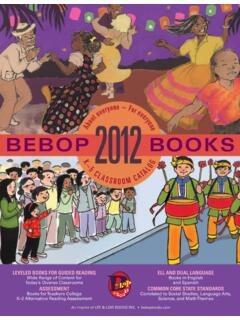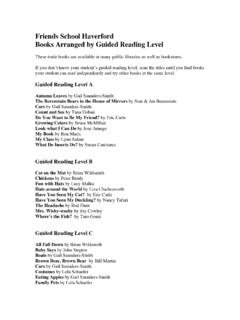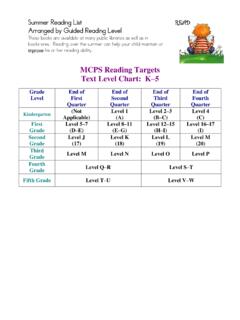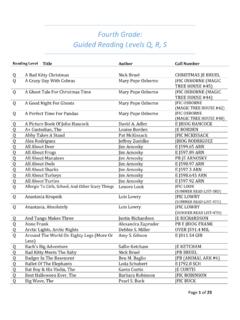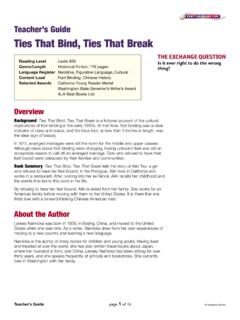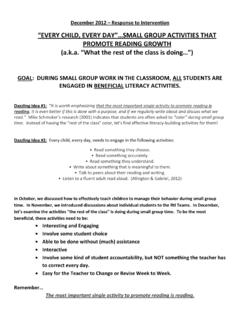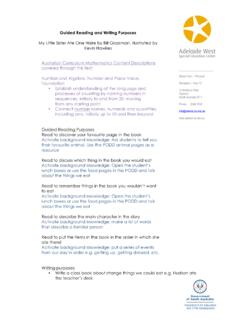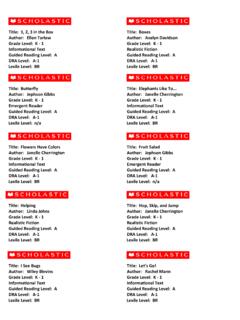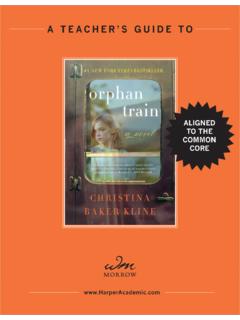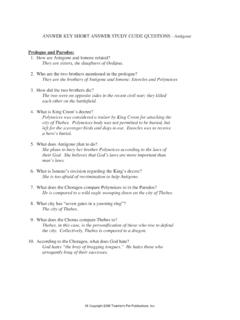Transcription of Guided Reading with SISTER, SISTER - Lee & Low Books
1 Bebop BooksPage 1 Guided Reading withSISTER, SISTER written and illustrated by Anne Sibley O BrienRealistic FictionGuided Reading : EDRA: 6 Intervention: 712 pages, 72 wordsFocus: using first person and third person singular verb endings Reading plural nouns understanding opposites attending to alternating sentence patternsSupportive Text Features: familiar words and concepts repetitive, patterned sentences humor used to engage the readerEssential Components of Reading Instruction: phonemic awareness, phonics,vocabulary development, fluency, comprehension strategiesHigh-frequency Words: I, like(s), to, my, her, make, when, be, a, inGetting Ready to Read1. Introduce the concept and vocabulary by asking open-ended questions: What are some things sisters and brothers agree about?
2 What are somethings they disagree about?Bebop BooksPage 2 Tell me about a time when you and your SISTER or brother did not agree. What kinds of activities do children like to do at home?2. Connect children s past experiences with the book vocabulary: Call children s attention to the title. Read: SISTER , SISTER . Ask them to predict what the story might be about. Show the back cover and read the copy. Ask children what kinds of thingsthe sisters might like to do. Have children suggest some words they might read in the story. Give children the book and have them look at the pictures. Ask them tonotice what the girls are Remind children of the strategies they know and can use with unfamiliarwords: Ask them, What will you do if you come to a word you don t know?
3 Encourage children to look at the picture and say the beginning sound ofthe word. Suggest that children also think about what the sisters are doing in thepicture and choose a word that makes sense in the Be aware of the following book and text features: The book contains several high-frequency words as well as these familiarplural nouns: songs, rocks, things, stories Many familiar verbs are used: sing, listen, study, play, keep, read, love There are two alternating patterned sentences. The sentences on each two facing pages describe opposite activities. The last sentence does not follow either of the the Book1. Set a purpose by telling children to read about the sisters to find out what eachgirl likes to Have children read quietly, but out loud.
4 Each child should be Reading at hisor her own pace. Children should not read in chorus. Listen to children as theyread by leaning close or bending down beside each Look for these Reading behaviors during children s first Reading : Do they identify more words by sight? Do they rely on the print and not just the pictures when Reading ? Do they pay attention to the endings on words? Do they read with increased confidence? Are they self-correcting to get meaning from the story? Have they begun to cross-check by using language patterns and lettersounds? Do they reread to check accuracy and meaning? Are they using chunks of words rather than individual letters whensounding out?Bebop BooksPage 3 Do they expect to get meaning from the text?
5 Do they make connections between the story and previous experiences? Are they asking questions about the story?4. As children read, suggest Reading strategies if they are struggling: Try sayingthe beginning of the word. Try looking at the picture for help. Encouragechildren to take a guess or read past the unknown Possible teaching points to address based on your observations: Call attention to all the high-frequency words children have used. Review how to find a known part in an unknown word. Show children how to use analogies to move from the known to theunknown when encountering new words. Review using grammar (syntax) to unlock words by considering thesentence structure or parts of speech in the sentence. Explore the story grammar characters, setting, problem, and so on.
6 Review how to determine what is important in a picture or sentence. Model asking questions or making I wonder .. statements to extendcomprehension. Review using punctuation marks to guide the meaning-making process. Work with first person and third person verb endings: I like .. My sisterlikes .. , and the plural noun stories, in which the -y ending changesto -ies. Model how to revisit the text to find specific examples or ideas in the SISTER , SISTER to find opposite the First Reading1. Have children confirm their predictions about what each girl in the story likesto Discuss what the sisters liked and how their preferences are not the same. Askchildren how the sisters choices are similar but also Reflect on how the sisters seem to deal with their Brainstorm with children some ways the sisters could play together despitetheir different interests and ways of doing Explore with children how some of the sisters differences are not really verydifferent from each other, for example, the way they each feel about Reading1.
7 Have children reread the book in a whisper voice or to a This is a time for assessment. While they are Reading , watch what children doand what they use from the teaching time. Alternatively, you might take arunning record on one child as an assessment of the child s Reading BooksPage 4 Cross-Curricular ActivitiesArt: Look through the book and find some evidence that one of the sisters likes topaint pictures. Divide children into two groups. Ask one group to paint a picturethat represents what the younger SISTER likes. Ask the other group to paint apicture that represents what the older SISTER likes. When the paintings arefinished, have the groups share their pictures and compare what they : Give children classroom instruments and let them make some musictogether.
8 Record the children s music and then play it back for them. Discusswhat children liked and didn t like about their music. Encourage them to choosetheir favorite parts of the children become aware of the concept of personal preferences. Talkabout how each person may like different parts of their music, just like they maylike different colors, foods, games, and so on. Make sure children understandthat all personal preferences are acceptable; their choices are neither right : Read children IF YOU FIND A ROCK by Peggy Christian. Then givechildren each an opportunity to find or choose a rock and observe it hand lenses so children can examine their rocks in detail. Using the bookas inspiration, make a chart or class book with children s observations, thoughts,and stories about their rocks.
9 You might even use a disposable camera or digitalcamera to photograph children s rocks and create illustrations for the chart : There are two sisters in the story. Take advantage of this fact to teach andpractice counting by twos. Use real objects, counters, or pictures to supportchildren as they Studies: The younger SISTER in SISTER , SISTER is in a wheelchair, yet itdoes not keep her from enjoying everyday activities. Help children becomesensitive to people with special needs. Encourage children to talk about how theymight help a child in a wheelchair participate in the activities of a normal schoolday. Also talk about the things families and communities do to make life easierfor people in : Have children make up pairs of sentences using first person and thirdperson singular verbs.
10 They might start with like/likes, but then introduceother familiar verbs such as run/runs, eat/eats, see/sees, and so on. Help eachchild record one pair of sentences on drawing paper and then let childrenillustrate their activity may be repeated with familiar singular and plural BooksPage 5 Guided Reading withHERMANA, HERMANAG uided Reading : EDRA: 6 Intervention: 712 pages, 67 wordsThe directions given for the introduction, first Reading , and second Reading of theEnglish edition can be used with the Spanish edition of the book. To read thebook successfully, children need the same kinds of support as their English-speaking classmates. Second language learners often benefit from acting out newwords, seeing pictures, and talking about them using concrete Spanish edition has alternating patterned sentences and many familiarwords, although some of the verb conjugations may not be familiar to allchildren.
